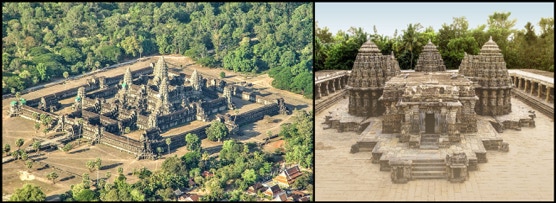OVERVIEW
KARNATAKA/ KHMER:
AN ARCHITECTURAL ENCOUNTER
The websites One Hundred Karnataka Temples and Forty Khmer Temples
(www.karnataka 100 temples.com and www.templemountains.org) survey two of the most accomplished traditions in sacred architecture. At the same time, they raise the question how two architectural languages, the Karnata Dravida and Khmer, 1 with such closely intertwined beginnings, spanning roughly the same period, honoring the same gods, sharing a common theology, even employing the same design tools, pursued such strikingly different trajectories? More concretely, how could two interpretations of the same cosmological metaphor, Mt. Meru, the “temple mountain,” produce both the expansiveness of Angkor Wat and the compression of the Kesava temple at Somanathapura? Fig 1 (a,b,bb)
The following few pages can at most outline a few parameters users of these two websites may find helpful in their own investigations of these monuments. Beginning with a necessarily broad-brush overview of Indic religions’ “emanative cosmology,” they highlight the models it offered and challenges it posed to an ecclesiastical architecture. A guide to two of the earliest extant Karnata Dravida and Khmer temples is then followed by summaries of the parallel but divergent development traced by the one hundred and forty temples on the two websites. These remarks conclude by asking if the two traditions’ differing understanding of ar common cosmogony might account for their radically dissimilar but equally compelling expressions of the “temple mountains?” Do they constitute two contrasting “architectural rhetorics,” one based on tropes of diminution, the other of amplification? (A series of endnotes provides background for some of the less familiar topics sketched in this overview.)
It is beyond the scope of these prefatory comments and the competence of their autodidactic compiler to provide more than an impressionistic comparison of two seminal bodies of architecture which have each enjoyed some of the most dedicated and perspicacious scholarship of the past century and a half. They are distinguished, if at all, by posing questions so rash more circumspect observers have avoided them; perhaps they can provoke more erudite and disciplined minds to correct their moris e imprudent speculations. Their inclusion here is only justified insofar as they provide a propaedeutic with which visitors to these sites can gain a deeper appreciation of the remarkable architecture they merely docuent.
